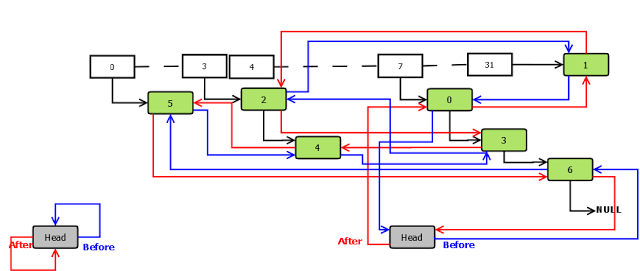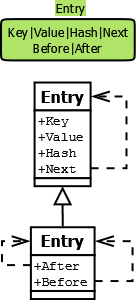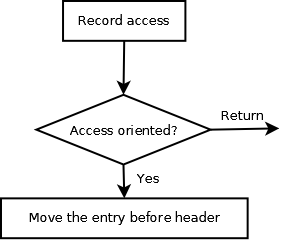Doubly Linked Hashmap
My implementation of Doubly Linked Hashmap in Java.
LinkedHashmap is used specially for LRU Cache (least recently used cache).
It maintains the insertion order of entries of hashmap.
Concept
See the LinkedHashmap datastructure.
Blue line marks the order of insertion; Red line marks the reverse order of insertion.
When the map is empty, there still left one Head element whose before/after pointers refer to itself.

Implementation
First, we define the structure of an Entry.
Having the Before/After pointers is the main difference from the general Hashmap Entry.

public class Entry<K,V> {
K key;
V value;
Entry<K,V> next;
Entry<K,V> before;
Entry<K,V> after;
public Entry(K k, V v) {
key = k;
value = v;
}
public boolean equivalent(Entry<K,V> e) {
return equivalent(e.getKey());
}
public boolean equivalent(K k) {
return key.equals(k);
}
public K getKey() { return key; }
public V getValue() { return value; }
public String toString() {
return key.toString() + " => " + value.toString();
}
}
Then, the basic functions of LinkedHashmap class
class LinkedHashmap<K,V> {
final int MAX_SIZE = 10;
LinkedList<Entry<K,V>>[] items;
Entry<K,V> head;
int size;
public LinkedHashmap() {
head = new Entry<K,V>(null,null);
items = (LinkedList<Entry<K,V>>[]) new LinkedList[MAX_SIZE];
head.before = head;
head.after = head;
size = 0;
}
public int hashCodeOfKey(K key) {
return key.hashCode() % items.length;
}
public void put(K key, V value) {
int x = hashCodeOfKey(key);
if (items[x] == null) {
items[x] = new LinkedList<Entry<K,V>>();
}
LinkedList<Entry<K,V>> collided = items[x];
/* Look for items with same key and replace if found */
for (Entry<K,V> e : collided) {
if (e.equivalent(key)) {
collided.remove(e);
size--;
break;
}
}
Entry<K,V> entry = new Entry<K,V>(key, value);
collided.add(entry);
entry.after = head;
entry.before = head.before;
entry.before.after = entry;
entry.after.before = entry;
size++;
}
public V get(K key) {
int x = hashCodeOfKey(key);
if (items[x] == null) {
return null;
}
LinkedList<Entry<K,V>> collided = items[x];
for (Entry<K,V> e : collided) {
if (e.equivalent(key)) {
return e.getValue();
}
}
return null;
}
public V remove(K key) {
int x = hashCodeOfKey(key);
if (items[x] == null) {
return null;
}
LinkedList<Entry<K,V>> collided = items[x];
for (Entry<K,V> e : collided) {
if (e.equivalent(key)) {
e.before.after = e.after;
e.after.before = e.before;
collided.remove(e);
size--;
return e.getValue();
}
}
return null;
}
public String toString() {
StringBuilder s = new StringBuilder();
Entry<K,V> traverser = head.after;
while (traverser != head) {
s.append(traverser.toString() + " , ");
traverser = traverser.after;
}
return s.toString();
}
}
Moreover, an Iterator will be useful of any collection.
Inside the LinkedHashmap class, we can define an Iterator.
public Iterator<Entry<K,V>> iterator() {
return new DoublyLinkedHahmapIterator();
}
private class DoublyLinkedHahmapIterator implements Iterator<Entry<K,V>> {
private Entry<K,V> curr;
private Entry<K,V> lastAccessed;
private int index = 0;
public DoublyLinkedHahmapIterator() {
index = 0;
curr = head.after;
lastAccessed = head;
}
public boolean hasNext() { return index < size; }
public boolean hasPrevious() { return index > 0; }
public int previousIndex() { return index - 1; }
public int nextIndex() { return index; }
public Entry<K,V> next() {
if (!hasNext()) throw new NoSuchElementException();
lastAccessed = curr;
Entry<K,V> e = curr;
curr = curr.after;
index++;
return e;
}
public Entry<K,V> previous() {
if (!hasNext()) throw new NoSuchElementException();
curr = curr.before;
index--;
lastAccessed = curr;
return curr;
}
public void remove() {
if (lastAccessed == null) throw new IllegalStateException();
if (curr == lastAccessed) //TODO why this?
curr = lastAccessed.after;
else
index--;
LinkedHashmap.this.remove(lastAccessed.getKey());
}
}
Then the toString() function could use the Iterator to traverse the collection by the insertion order.
public String toString() {
StringBuilder s = new StringBuilder();
Iterator<Entry<K,V>> iterator = this.iterator();
while (iterator.hasNext()) {
s.append(iterator.next().toString() + " , ");
}
return s.toString();
}
Usage
LRU Cache
LRU Cache is used for cache the frequently used resources rather than retrive them from outer source with limited storage (especially in RAM).

The method public V get(K key) should be modified. Every requested Entry will be moved to the position before/after the Head.
public V get(K key) {
int x = hashCodeOfKey(key);
if (items[x] == null) {
return null;
}
LinkedList<Entry<K,V>> collided = items[x];
for (Entry<K,V> e : collided) {
if (e.equivalent(key)) {
if (head.after != e) {
// remove this entry
e.before.after = e.after;
e.after.before = e.before;
// add this entry back to head
e.after = head;
e.before = head.before;
e.before.after = e;
e.after.before = e;
}
return e.getValue();
}
}
return null;
}
Reference
1. code of Doubly Linked List
2. guide of Linked Hashmap
3. Cracking the Coding Interview, C8Q10 </blockquote>
 Category:
Category: 